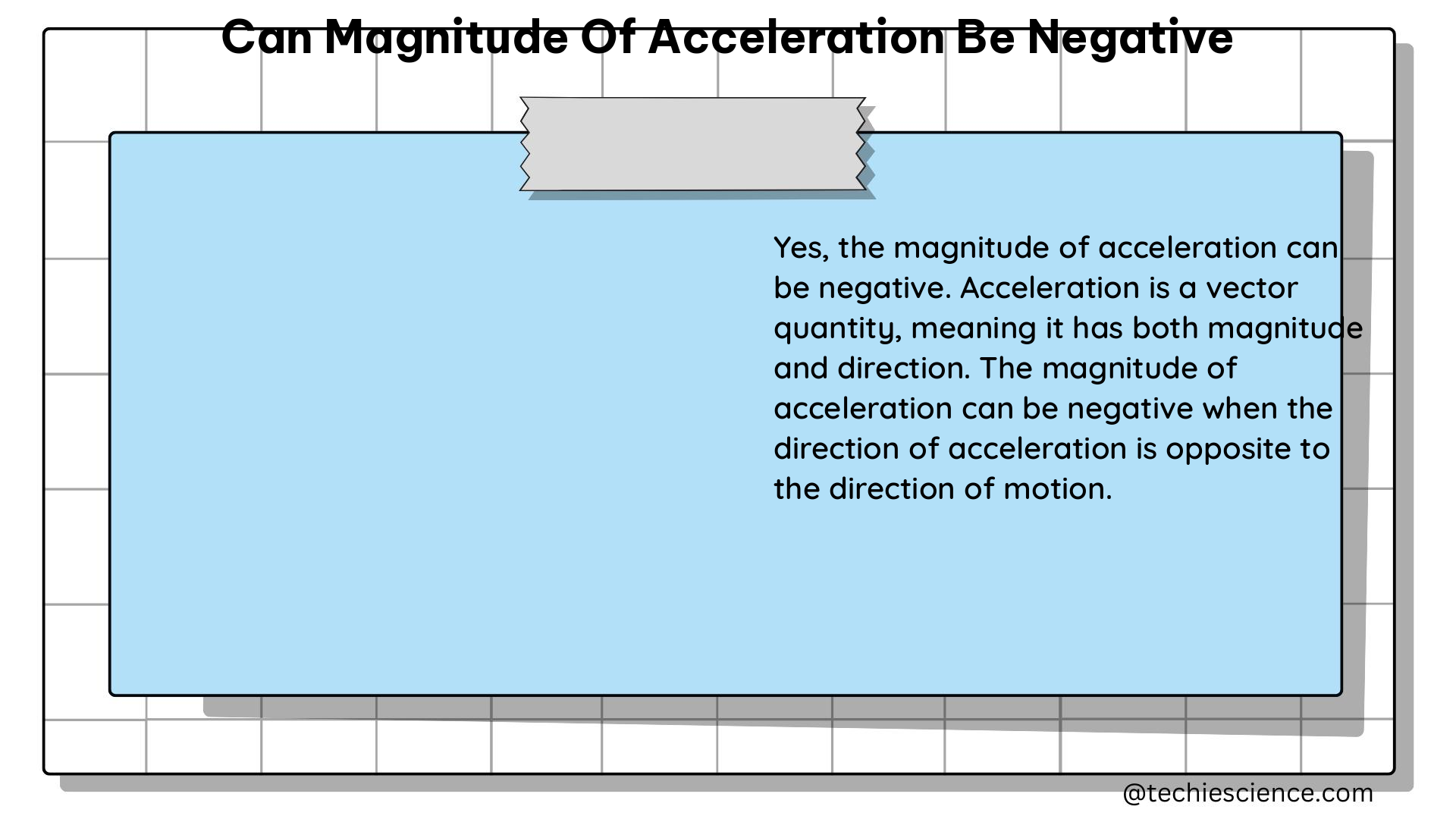The magnitude of acceleration can indeed be negative, but it’s important to understand the nuances of this concept. Acceleration is a vector quantity, meaning it has both a magnitude and a direction. The magnitude of acceleration refers to the rate of change in an object’s velocity, while the direction indicates whether the velocity is increasing or decreasing.
Understanding Acceleration as a Vector Quantity
Acceleration is a vector quantity, which means it has both a magnitude and a direction. The magnitude of acceleration represents the rate of change in an object’s velocity, measured in units of distance per time squared (e.g., meters per second squared, m/s²). The direction of acceleration indicates whether the velocity is increasing or decreasing.
When the velocity of an object is decreasing, the acceleration is often referred to as “negative acceleration” or “deceleration.” However, it’s crucial to note that the term “negative” in this context refers to the direction of the acceleration, not its magnitude. The magnitude of acceleration is always a positive value, even when the acceleration is in the negative direction.
Negative Acceleration and Deceleration

Negative acceleration, or deceleration, occurs when the velocity of an object is decreasing. This happens when an object is slowing down or moving in the opposite direction of its initial velocity. In this case, the acceleration vector points in the opposite direction of the object’s motion.
For example, consider an object moving in a straight line with an initial velocity of 10 m/s. If the object slows down at a rate of 2 m/s², its velocity after 5 seconds will be 5 m/s. The acceleration in this case is -2 m/s², indicating that the velocity is decreasing. However, the magnitude of the acceleration is still 2 m/s², which is a positive value.
Magnitude of Acceleration is Always Positive
It’s important to understand that the magnitude of acceleration is always a positive value, regardless of the direction of the acceleration. The “negative” in “negative acceleration” refers to the direction of the acceleration, not its magnitude.
The magnitude of acceleration represents the rate of change in an object’s velocity, and it is always a positive value. This is because the magnitude of a vector quantity is a scalar value that represents the size or strength of the vector, without considering its direction.
Formulas and Equations
The relationship between acceleration, velocity, and displacement can be expressed using the following kinematic equations:
- Displacement (d) = Initial Velocity (v₀) × Time (t) + 1/2 × Acceleration (a) × Time² (t²)
- Velocity (v) = Initial Velocity (v₀) + Acceleration (a) × Time (t)
- Acceleration (a) = (Final Velocity (v) – Initial Velocity (v₀)) / Time (t)
These equations can be used to calculate the magnitude of acceleration, even when the acceleration is in the negative direction.
Examples and Applications
-
Braking a Car: When a car is braking, the acceleration is negative (deceleration). For example, if a car is traveling at 60 mph (26.8 m/s) and it decelerates at a rate of 5 m/s², the magnitude of the acceleration is 5 m/s², even though the direction of the acceleration is negative.
-
Throwing a Ball Upward: When a ball is thrown upward, the acceleration due to gravity is negative. The ball’s velocity decreases as it moves upward, and the magnitude of the acceleration due to gravity is 9.8 m/s².
-
Falling Object: When an object is falling under the influence of gravity, the acceleration is negative (downward). The magnitude of the acceleration due to gravity is 9.8 m/s².
-
Projectile Motion: In projectile motion, the vertical component of the acceleration is negative due to the downward pull of gravity, while the horizontal component of the acceleration is zero (assuming no air resistance).
DIY Experiment
To better understand the concept of negative acceleration, try the following experiment:
- Find a smooth, flat surface and place a small object on it, such as a toy car or a marble.
- Give the object a gentle push to get it moving in a straight line.
- Quickly place your hand in the path of the object to slow it down.
- Observe the direction and magnitude of the object’s acceleration as it slows down.
By performing this experiment, you can see firsthand how negative acceleration, or deceleration, affects the motion of an object.
Conclusion
In summary, the magnitude of acceleration can indeed be negative, but this simply refers to the direction of the acceleration, not its magnitude. The magnitude of acceleration is always a positive value, regardless of the direction of the acceleration. Understanding the vector nature of acceleration and the distinction between magnitude and direction is crucial for understanding and applying the principles of kinematics and dynamics.
References:
- How can acceleration be negative? – Socratic
- Kinematics | University Physics – Lumen Learning
- Can the value of acceleration be negative : r/AskPhysics – Reddit
- Nardi Final Flashcards | Quizlet
- Identifying Positive and Negative Acceleration | Physics – Study.com

I am Alpa Rajai, Completed my Masters in science with specialization in Physics. I am very enthusiastic about Writing about my understanding towards Advanced science. I assure that my words and methods will help readers to understand their doubts and clear what they are looking for. Apart from Physics, I am a trained Kathak Dancer and also I write my feeling in the form of poetry sometimes. I keep on updating myself in Physics and whatever I understand I simplify the same and keep it straight to the point so that it deliver clearly to the readers.